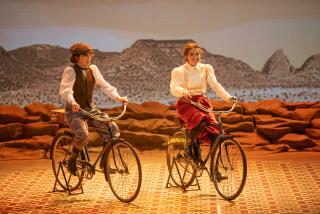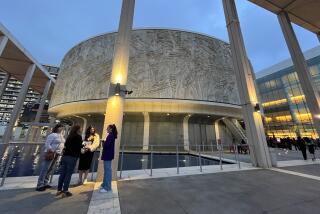Hollywood Fringe Festival performs its own way
Growing up in suburbanWashington, D.C., Ben Hill caught acting fever when he first saw “Our Town.” One of his first roles was professor Harold Hill, the scam artist turned town savior of “The Music Man.”
“I was just enraptured,” said Hill, an unwaveringly upbeat tech nerd who got his first IBM computer when he was 7 and works in financial management when he’s not doing song-and-dance numbers.
This week — like professor Hill — Ben Hill, 36, is hoping to rally the masses through the transformative power of performance. As founder-director of the 3-year-old Hollywood Fringe theater and arts festival, he’s marching at the head of a 10-day parade of plays, stand-up comedy, cabaret, magic acts and music, plus other unclassifiable amusements.
By the time the non-curated festival winds down Sunday evening, audiences will have absorbed about 1,000 performances of some 250 different shows. The majority are low-budget productions with modest financial resources but no lack of do-it-yourselfer enthusiasm, or ideas about how events like the Fringe represent the forward edge of theater and theatrical production.
“We truly are the DIY generation of artists,” said Brett Colbeth, who’s performing with Gowrie Hayden in Zenith Ensemble’s premiere of playwright Cal Barnes’ two-hander “Rise” at Theatre Asylum. “So no longer are we ‘actor,’ ‘writer,’ ‘producer.’ We’re actors-writers-producers-directors. And that is going to be the future of entertainment.”
Geographically and spiritually, the Fringe’s home base is Hollywood’s Theatre Row, a stretch of Santa Monica Boulevard roughly book-ended by El Centro and La Brea avenues. Many Fringe participants are associated with L.A.’s sprawling community of sub-99-seat theaters, several of which dot the neighborhood.
Near the epicenter stands the festival’s temporary headquarters, Fringe Central Station, in a handsome 6,000-square-foot, two-story brick structure on Santa Monica just west of Vine Street. The festival’s opening-night party there drew 600 people.
Throughout the day and late into the evening, Central Station serves as a community watering hole, entertainment lounge and artistic brainstorming chat room, and not only because of the $3 Pabst Blue Ribbons, Hill joked.
“I suspect there are a lot of places where film people meet but there aren’t a lot of places where arts people meet,” he added.
Last Sunday afternoon, Central Station’s interior hummed with chatter. Artists and performers worked the growing crowd, passing out laminated cards advertising their shows.
“There’s so much great theater in L.A., [but] people don’t like to take a chance on it as much as they do in New York,” said Barnes as he and Colbeth watched a cabaret act warm up.
“What’s so great about the Fringe,” Barnes continued, “is that the ticket prices are low, you can come here and talk to people about what they’ve seen, and what’s good, and there’s so much great work.”
The Hollywood Fringe, which takes Scotland’s renowned Edinburgh Fringe as its role model, began as what Hill describes as “almost a family business.” Hill’s wife, Stacy Jones, is publicity director. Hill’s cousin, Abbie Wagoner, serves as food and beverage manager. Dave McKeever, the festival’s producing director, and Hill are old college chums who formerly helped start a new play festival in Washington.
During most of the year, Fringe staff members work out of their homes, Skype a lot and occasionally meet up in the flesh at coffee bars. “We’re a modern organization in that sense,” Hill said. “And we pay each other almost nothing. There are bartenders who made more than the staff does.”
In three years the Fringe’s budget has grown from $100,000 to “pushing $400,000” this year, Hill said. By the festival’s second year, 100% of ticket sales were being returned to the artists.
By helping small companies and solo performers to produce and promote their shows, and by providing a network that puts artists in touch with one another, the Fringe seeks to advance the goals of its website mission statement: “See Shows. Make Friends. Have Fun.”
“They’ve created a fertile environment for first-time producers like me,” said Deborah Geffner, who’s producing Jon Courie’s witty satire of the Hollywood underclass, “Jennifer Aniston Stole My Life,” at the Hudson Theatres as part of the Fringe.
“I never produced a play before because it just seemed impossible,” continued Geffner, a veteran actor (“All That Jazz”) and director. “Here we’ve got theater owners offering theaters and giving discounts. Press people want to come because it’s the Fringe, so you’re pre-buzzed and audiences are sort of pre-buzzed.”
Jon Armstrong, who is chairman of the board of trustees of the Magic Castle, and is performing his one-man show “I Do Card Tricks and I’m Funny” at the Fringe, credits the festival with helping to break down the barriers that tend to separate and isolate different types of L.A. artists.
“People are cliques: Magicians stay over here, and the actors stay over here, and the musicians stay over here,” Armstrong said. “And I don’t think it should be that way. And the more we can actually all come together and learn a little bit, sort of feed off of each other, we all become better artists.”
Robert J. Litz, an award-winning veteran playwright and screenwriter whose trenchant two-character drama “Cycles,” about dueling Boston real estate entrepreneurs, is playing a few doors from Central Station, suggested that most L.A. small theater is already under the radar compared with other local entertainment forms.
“L.A. theater, it’s all fringe of the entertainment business,” Litz said. “I think you would have to say that we live at the fringe of the film and television industry. It’s a fringe of the fringe.”
Michael Shaw Fisher, who wrote the book, lyrics and music for “Doomsday Cabaret” and also performs in it, said the festival confirms there’s an audience for theater and performance that’s willing to step outside its comfort zone.
“At the same time, it’s a demanding audience,” Fisher said. “I know that when I come out to the Fringe I can’t just throw out crap. I have to come ready.”
More to Read
The biggest entertainment stories
Get our big stories about Hollywood, film, television, music, arts, culture and more right in your inbox as soon as they publish.
You may occasionally receive promotional content from the Los Angeles Times.







